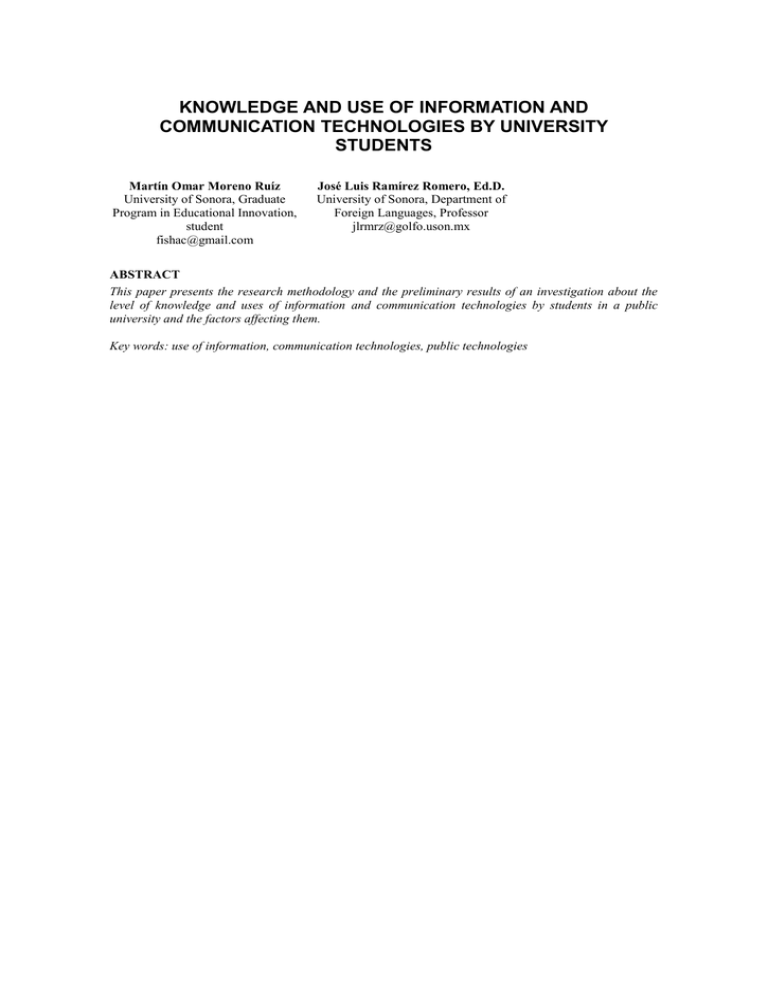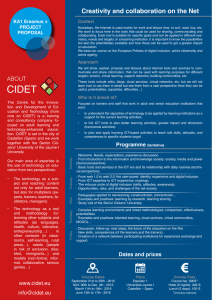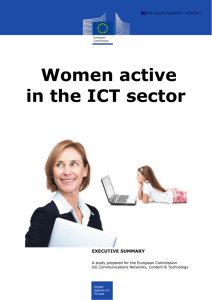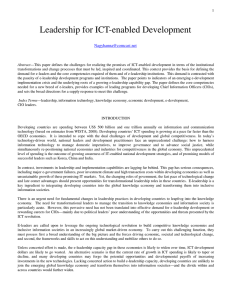knowledge and use of information and communication technologies
Anuncio

KNOWLEDGE AND USE OF INFORMATION AND COMMUNICATION TECHNOLOGIES BY UNIVERSITY STUDENTS Martín Omar Moreno Ruíz University of Sonora, Graduate Program in Educational Innovation, student fishac@gmail.com José Luis Ramírez Romero, Ed.D. University of Sonora, Department of Foreign Languages, Professor jlrmrz@golfo.uson.mx ABSTRACT This paper presents the research methodology and the preliminary results of an investigation about the level of knowledge and uses of information and communication technologies by students in a public university and the factors affecting them. Key words: use of information, communication technologies, public technologies INTRODUCTION The incorporation of Information and Communication Technologies (ICT) are among the most important transformations in higher education noted by scholars such as Brunner (2000), Bates (2001) and Cabero (2005). While this incorporation has been the subject of many studies, the need to study the ways in which the incorporation of ICT is conducted in higher education institutions (HEI) remains, especially by the largest group of users: the students. Some of the most important studies regarding the use of ICT by university students are those of Coll, Mauri and Onrubia (2008), ECLAC (2006), and Ramirez (2008). In Mexico, the following studies were found: Sanchez et al (2006); Crovi (2007), Sotelo, Ramos and Tanori (2009), Lopez (2007), and Murrieta, Reyes and Reyes M (2009). At the University of Sonora, the main projects are those of Ojeda (2001), Basurto (2004), Diaz (2004), Duran (2005) and Gonzalez (2009). However, none has addressed the issue of the potential factors that affect the level of knowledge and use of ICT by university students. To provide elements in that direction, we conducted a study aimed to characterize the knowledge and use of ICT by students of the University of Sonora, and the factors that influence such knowledge and practices. THEORETICAL FRAME Our theoretical framework examines the historical context in which ICTs were incorporated in education, the classification of these technologies by Turban (2008), the uses and potential functions of ICT, the advantages associated to its use, and the possible factors influencing it. Due to space limitations, in the next paragraphs only the last three points are developed. Based on authors such as Aparici and Davis (1992), Cebrian (1992), Sauve (1995), Parcerisa (1996) and Marques et al. (2002), we argue that the main uses and potential roles of ICT in education can be categorized into the following: as a means of expression and creation of multimedia and communication channels, as a source of information, guidance tool for student diagnosis and remedial work, as a teaching and evaluation tool, and as a recreational and cognitive development resources. According to Marques et al. (2002), the main advantages associated with the use of ICT in university environments include: students motivation, continual interaction and intellectual development, learning from mistakes; greater communication between teachers and pupils; encouragement towards cooperative learning; interdisciplinary and digital literacy; audiovisual skills to search and to select information; improvement of expression and creativity; and greater access to information. Finally, the framework also addresses issues related to the two main factors that seem to influence the knowledge and use of ICT by university students, namely: personal ones such as motivation (Van Dijk: 2005), access (Crovi: 2007, and Lopez, 2009), and the level of technology adoption (Van Dijk, 2005) and institutional ones such as infrastructure and level of dissemination. METHODOLOGY The research approach used followed Bisquerra (2004) descriptive which aims to characterize the population according to selected variables, without manipulating any of them. To collect the data, we conducted a cluster sampling that included the areas of knowledge in which the University of Sonora is organized. The 366 subjects who participated in the study were selected from a total population of 7,405 students who were enrolled in third and fifth semester and had already taken a course offered by the university related to the use of information technologies and communication. The subjects were administered a 84 items questionnaire organized into four sections, namely: general information, ICT knowledge, and personal and institutional factors that influence the use of ICT. To measure the variables on the use of ICT we used part of the questionnaire prepared by Henriquez and Organist (2009) with modifications to adapt it to the University of Sonora context. To measure the variables related to personal factors, we used part of the questionnaire prepared by Cabero and Llorente (2006) which was also adapted to the students at the University of Sonora. The questionnaire showed an internal consistency coefficient of .883. Questions were related to the following aspects: level of knowledge about information and communication technology, perception of motivation and interest in the use of ICT for learning, access to technology, and levels of technology adoption/ acceptance. Questions related to institutional factors were developed by the authors of this paper which included questions about the institutional infrastructure and the level of diffusion given to existing equipment. We calculated summary measures of central tendency and dispersion and frequency tables using SPSS version 18. Analysis techniques were applied for classification (cluster k - mean). Data was analyzed comparing it with the provisions of the variables in the theoretical approach to the study. RESULTS 1.-Knowledge and use of information and communication technologies by students of the University of Sonora. Over 50% of respondents reported having taken at least one course concerning the use of ICT and 95% of them claimed to have an average of 6 years of experience in the use of ICT. The remaining 5% reported between 1 and 3 years of experience in the use of ICT. Regarding the level of knowledge about the management of computer equipment and peripherals, 25% claimed to have complete knowledge, 53% said they have moderate knowledge and the rest said they had no knowledge at all. Only 10% of surveyed students considered having complete knowledge of informational activities such as searching, selecting and processing information using electronic media; 52% claimed to have a low to moderate knowledge and the remaining 38% said it had no knowledge. Only 4.5% of respondents said they were able to combine two or more technologies to solve a specific problem; 39.5% claimed to have low to moderate knowledge, and the remaining 56% claimed to have no knowledge at all. The programs most used by students are word processors, browsers, email and forums. The medium most frequently used by students is the internet, which is used primarily for recreation. 16.5% of the respondents mentioned never have used digital databases or encyclopedias; 25% reported using this technology once a year; 46% reported using it between 5 and 10 times per month and the rest reported using this technology four times a week. In sum: students claimed to have a good level of knowledge and experience related to ICT except as it relates to searching, selecting and processing information from any electronic medium or to combining two or more technologies to solve a specific problem. We also found that students basically used ICT as means of expression, communication and entertainment, leaving aside other great potential educational functions such as information search, guidance, diagnosis, remedial work, educational support, and evaluation as well as learning from errors, skill development and selection of information. Similar results were reported by Henriquez and Organist (2009) with students from the Autonomous University of Baja California (UABC). 2. Potential factors influencing the knowledge and use of ICT by students of the University of Sonora. Regarding the personal factors that influence the use of ICTs, we found that 90% of the students have personal computers and 60% of computers owned by students are laptops; 70% have Internet access at home, while 22% is connected to school (UNISON); 4.5 uses an internet connection from work and 3.5% connects from an internet cafe. About 80% of students felt that the use of ICT motivates them and that computer and Internet are important in their studies. The same percentage believes that computer and internet strengthen their research capacity by allowing them to work collaboratively. More than a third of students considered that ICT improves their academic performance by promoting new areas of learning and spreading the educational process beyond the classroom. Regarding the students’ relationship with ICT (technology adoption) we found that 84% of students surveyed said they use ICT to do their homework and feel able to use technology in different ways and for various purposes. The remainder admitted to be just learning. Regarding institutional factors, we found that 78% of respondents reported having good or excellent IT infrastructure and IT services, and 30% reported that there is a need for wider dissemination of the technology available to students existing at the University of Sonora. In sum, in relation to the factors mentioned in the theoretical framework, such as Van Dijk (2005), Crovi (2007) and Lopez (2009) that seem to influence the knowledge and use of ICT by students, we could argue that with regard to the personal factors, students declared to have a good level of personal equipment and access to ICT, they are positively motivated towards the use of technologies and consider these important for their studies, and considered to have a good level of technology adoption. As for the institutional factors, students seem to have the necessary infrastructure but a third of them considered it necessary to increase the level of dissemination. The above findings seem to suggest that in general students have the personal and institutional factors mentioned in the literature as highly related to knowledge and use of ICT. Therefore, what it is necessary now is to emphasize the educational applications of ICT and to provide wider information related to the institutional ICT related services. CONCLUSIONS Although the surveyed students reported a high level of ICT related knowledge, they obtained a low score on the level of strategic awareness of ICT and its uses as problem-solving devices or as means to achieve specific academic goals. The problem with this is that while the institution is making a big investment in equipment and training, students are not being taught how to use ICT effectively for academic purposes, with the consequent waste of resources, both material and human. We hope that this work serves as a wakeup call in that direction. REFERENCES 1. Aparici, R. y Davis, B (1992). “La educación en los medios de comunicación”. En varios: European conference about information technology in education, Barcelona: Congreso TIE, 546-556. 2. Bates, A.W. (2001). Cómo gestionar el cambio tecnológico. Estrategias para los responsables de centros universitarios. Barcelona: Ediouc. Gedisa. 3. Bisquerra, R. (cood) (2004): Metodología de la investigación educativa, Madrid, La Muralla. 4. Basurto, R. (2004). “Tecnologías de la Información y la Comunicación, y una nueva ciudad: Como se formula el sentido de lo urbano y la ciudadanía, caso Hermosillo, Sonora” Ed. UNAM. México, DF. 5. Brunner, J.J. (2000). Globalización y el futuro de la educación: tendencias, desafíos y estrategias. Seminario sobre prospectiva de la educación en la región de América Latina y el Caribe. UNESCO. Santiago de Chile. Available in: http://www.schwartzman.org.br/simon/delphi/ pdf/brunner.pdf. 6. Cabero, J y Llorente M. (2006). La rosa de los vientos: Dominios tecnológicos de las TIC por los estudiantes. Grupo de Investigación Didáctica. Madrid. 7. Cabero, J. (2005). “Las TIC y las universidades: retos, posibilidades y preocupaciones”. Revista de la Educación Superior, julio-septiembre, año/vol. XXXIV (3), núm. 135. (México Asociación Nacional de Universidades e Instituciones de Educación Superior, ANUIES). 8. 9. Duran, A. (2005).”Las Nuevas Tecnologías de la Información y la Comunicación en apoyo a la educación Universitaria”. Ed. Universidad de Sonora, México. González, E. (2009) “La enseñanza de las nuevas tecnologías de la Información y la Comunicación en el nuevo modelo de la Universidad de Sonora” Ed. Universidad de Sonora. México. 10. Henríquez y Organista (2009) “Definición y estimación de tipos y niveles de uso tecnológico: una aproximación a partir de estudiantes de recién ingreso a la universidad, [artículo en línea]. EDUTEC, Revista Electrónica de Tecnología Educativa. Núm.30 Available in: http://edutec.rediris.es/revelec2/revelec30/. 11. López, M. (2007). “Uso de las TIC en la educación superior de México. Un estudio de caso”. Apertura, noviembre, año/vol. 7, núm. 007. Universidad de Guadalajara: México. Available in: http://www.udgvirtual.udg.mx/apertura/num7 /pdfs/tic_educacion.pdf. 12. Marquès, P. (2002): “El impacto de las TIC en el mundo de la educación. Avanzando hacia la escuela del futuro”. Departamento de Pedagogía Aplicada, Facultad de Educación, UAB Available in:http://dewey.uab.es/pmarques/astur2.htm. 13. Murrieta G., Reyes E. y Reyes M. (2009). “Alfabetización Tecnológica en Estudiantes Universitarios”. Memorias Electrónicas del X Congreso Nacional de Investigación Educativa. Veracruz, México. 14. OCDE (2005) “Are Students Ready for a Technology-Rich World? What PISA Studies Tell Us”. OCDE. Available in: http://www.oecd.org/dataoecd/28/4/35995145 .pdf. 15. Ojeda, M. (2001). “Informática Educativa en la enseñanza Universitaria”. Ed. Universidad de Sonora. México. 16. Onohwakpor, E. Josephine and Tracy, Efe Rhima (2008). "A survey of teachers' level of computer literacy and awareness of information and communication technology for application of science, technology and mathematics education." Computing and Information Systems 12.2 Availablein:http://find.galegroup.com/gps/sta rt.do?prodId=IPS&userGroupName=unison. 17. Parcerisa, A. (1996). Materiales curriculares. Barcelona: Graó. 18. Pelgrum W.J. (2001) “Obstacles to the integration of ICT in education: Results from a worldwide educational assessment” Elsevier Science Ltd. Oxford. 19. Ramírez, J. L. (2008). “La tecnología para el cambio educativo: Reflexiones y experiencias”. Promesas y realidades en el uso de las tecnologías de la Información y la Comunicación en la educación: El caso de Costa Rica. Ed. UANL. Monterrey, México. 20. Ramírez, J. L. y Sorden, S (2008) “Innovando de manera colaborativa: una experiencia entre académicos de universidades fronterizas”, en: Magda García Quintanilla y Martha Casarini Ratto (Compiladoras) La tecnología para el cambio educativo. Universidad Autónoma de Nuevo León. 21. Ramírez, J. L. (2001). “Educación y computadoras: una aproximación al estado actual de la investigación en México”. Revista Mexicana de Investigación Educativa, VI, 2,119-138. Available in: http://www.comie.org.mx. 22. Rowntree, L. (1991). Teaching through selfinstruction.Londres: Kogan Page. 23. Salinas, J. (1992). Diseño, producción y evaluación de vídeos didácticos. Palma de Mallorca: Universidad de las Islas Baleares. 24. Sánchez y Colbs. (2006). Diagnóstico en el uso de las TIC de los estudiantes de primer ingreso a nivel superior en la Universidad de Colima. México: Ceupromed. 25. Sauvvé, L (1995) “Les Medias: des outils indispensables por réduire la distance”. En Dessaints, Conception de cours: guide de planification et de rédaction. Sainte-Foy, Presses de l’Université du Québec. 26. Sierra, F (2001) “La tecnología informática en la escuela”. Ciberhabit. INEGI. México. 27. Schwartzman, S (2001). “El futuro de la educación en América Latina”. Séptima Reunión del Comité Regional Inter gubernamental del Proyecto Principal de Educación en América Caribe.UNESCO. Latina y el 28. Sotelo, M.; Ramos, D. y Tanóri, A. (2009). “Habilidades y actitudes en estudiantes que cursan materias en modalidad virtual presencial en una institución de educación superior”, X Congreso nacional de Investigación Educativa. Veracruz, Veracruz. Available in: http://www.comie.org.mx/congreso/memoria/ v10/pdf/area_tematica_01/ponencias/0978F.pdf. 29. Turban, Leidner, McLean, Wetherbe (2008).InformationTechnologyforManageme nt:Transforming Organizations in the Digital Economy (6th Edition). Páginas 17, 41. Editorial John Wiley & Sons. Available in: http : //ciam. ucol. Mx / analisisciam 2006 % 200 3 % 20 de % 20 oct % 20 de % 2006 - 1 .pdf. 30. Van Dijk, J. (2005). The divide.Sage. Estados Unidos. deepening 31. Winocur, R. (2006). “Internet en la vida cotidiana de los jóvenes”. Revista Mexicana de Sociología, año 68, núm. 3, julioseptiembre, México: IIS-UNAM.





